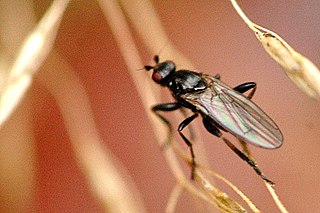
The Calliphoridae are a family of insects in the order Diptera, with almost 1,900 known species. The maggot larvae, often used as fishing bait, are known as gentles. The family is known to be polyphyletic, but much remains disputed regarding proper treatment of the constituent taxa, some of which are occasionally accorded family status.

Sphaeroceridae are a family of true flies in the order Diptera, often called small dung flies, lesser dung flies or lesser corpse flies due to their saprophagous habits. They belong to the typical fly suborder Brachycera as can be seen by their short antennae, and more precisely they are members of the section Schizophora. There are over 1,300 species and about 125 genera accepted as valid today, but new taxa are still being described.

The Lauxanioidea are a superfamily of flies that includes the two large families, the Lauxaniidae and Chamaemyiidae, and the small family Celyphidae. Generally, they are small to medium, densely populated, coloured flies. The Chamaemyiidae live as parasites on insects. The family Celyphidae look like beetles.

Rhagionidae or snipe flies are a small family of flies. They get their name from the similarity of their often prominent proboscis that looks like the beak of a snipe.

Bibionidae is a family of flies (Diptera) containing approximately 650–700 species worldwide. Adults are nectar feeders and emerge in numbers in spring. Because of the likelihood of adult flies being found in copula, they have earned colloquial names such as "love bugs" or "honeymoon flies".

The Celyphidae, commonly known as beetle flies or beetle-backed flies, are a family of flies. About 115 species in about 9 genera are known chiefly from the Oriental and Afrotropic biogeographic regions with one lineage in the New World.

Xylota is a Holarctic genus of hoverflies similar in structure to the related genera Chalcosyrphus and Brachypalpoides. As the larvae are saprophytic they're usually found in rotting wood. The adult flies are generally associated with woodland and woodland edges and can often be seen running over the upper sides of leaves. Unlike other syrphids the adults of many species rarely visit flowers preferring instead to gather pollen from leaf surfaces. There are over 100 described species of which 12 can be found in Europe. Seven species have been recorded in Britain. Identification of species has been difficult and identifiction by photographs is risky.
Isosturmia is a genus of flies in the family Tachinidae.

Thelaira is a genus of flies in the family Tachinidae.
Eurynogaster is a genus of flies in the family Dolichopodidae, endemic to Hawaii. It is part of the Eurynogaster complex of genera, which also includes the genera Adachia, Arciellia, Elmoia, Major, Sigmatineurum, Sweziella and Uropachys.

Dexia is a genus of flies in the family Tachinidae. Most larvae are parasitoids of beetles (Scarabaeidae).

Acelyphus is a genus of beetle flies. It is known from the Indomalayan realm.

Spaniocelyphus is a genus of beetle flies known from the Indomalayan realm.
Idiocelyphus is a genus of beetle flies. It is known from the Indomalayan realm. Most are from the Philippines.

Atrichopogon is a genus of biting midges, small flies in the family Ceratopogonidae.
Elmoia is a genus of flies in the family Dolichopodidae, endemic to Hawaii. It is part of the Eurynogaster complex of genera. The genus is named in honor of D. Elmo Hardy.
Oocelyphus is a genus of beetle flies. It is known from the Oriental realm.
JoAnn Marie Tenorio was an American entomologist who also worked in publishing in Hawaii. She was co-author of two popular manuals, What Bit Me? (1993) and What's Bugging Me? (1995).











